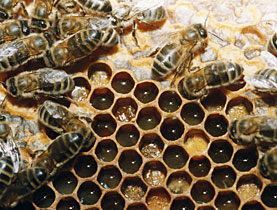
Experts gear up to counter bee deaths

Bees are dying mysteriously in Switzerland as they are in other parts of the world, with scientists and beekeepers at a loss to explain the phenomenon.
Specialists are particularly concerned by the potential impact on agriculture and food production, as bees play an important role in pollinating plants. The problem is considered so serious that a bee health service might be even on the cards.
Around 20 per cent of hives in Switzerland did not survive last winter, double what is considered a normal death rate, continuing a trend that dates back to 2002.
The Swiss are not alone in this situation. In the United States, an estimated third or more of the country’s commercially managed hives were decimated after the winter season.
For beekeepers everywhere, this means first and foremost a loss of revenue.
But perhaps more worryingly, the insects’ disappearance could have a much wider impact if their numbers keep on dropping, according to William Schneeberger, the former president of the Swiss Beekeeping Federation.
One third of humanity’s food depends on pollination by insects, and about 80 per cent of that pollination is done by honeybees.
Mystery unsolved
Despite all the attention paid to the bee deaths so far, researchers have been unable to pin down a single cause. What is striking about them is their wide geographical spread and the fact that the phenomenon keeps occurring.
Cases where hives have been found almost completely deserted after the winter have been given names that betray a lack of knowledge – Mary Celeste Syndrome in Britain and Colony Collapse Disorder in the US.
The Swiss consider disease as the most likely cause.
“The varroa mite is the main reason the bees are dying off in the winter,” says Jean-Daniel Charrière of the Agroscope federal research centre. “It a is a pathogen that infects the bee’s blood, weakening its immune system and spreading viruses.”
Other factors are also believed to play a role, including breeding bees too intensively, use of pesticides, a lack of food, moving hives, mobile phone transmissions, genetically modified crops and a lack of people willing to become beekeepers.
But neither Schneeberger nor Charrière believes that these causes have a major impact in the deaths.
Given the lack of knowledge, international collaboration has become vital to find solutions. Since 2006, the Swiss Bee Research Centre has been coordinating the Prevention of Honeybee Colony Losses (Coloss), involving over 100 researchers from 28 countries in Europe as well as the US.
Coloss aims to make a systematic inventory of bee losses in each country. It will consider whether it is disease (viruses, bacteria) or environmental factors which are decimating colonies.
The group is also studying how improve bee resistance through selective breeding.
Government measures
Swiss beekeepers will need all the help they can get, especially as for most of them it is not their main activity. The Federal Agriculture Office is considering ways of boosting apiculture in response to demands from parliament.
However, beekeepers will have to find a way of coordinating their efforts and their different associations, and they shouldn’t expect any extra financial help from the authorities.
A working group that was set up to find solutions to the bee crisis is to publish its recommendations this month. These include training to help beekeepers improve their knowledge and support for the breeding of queens, the key player in any colony.
Finally, a health service to be managed by the beekeeping associations could be set up. The aim would be track bee numbers more efficiently and gather precise statistics for the whole country.
swissinfo, based on an article in French by Catherine Vuffray
Varroa destructor is an external parasitic mite that attacks honeybees. The disease caused by the mites is called varroatosis.
Varroa can only replicate in a bee colony. It attaches itself to the insect’s body and weakens it by sucking its blood. This is how the mite spreads viruses like Deformed Wing Virus. A significant infestation will destroy a bee colony, usually in the late autumn through early spring.
With the exception of some resistance in the Russian Honey Bee, the European Apis mellifera bees are almost completely defenceless against these parasites.
The Varroa mite is the parasite with the biggest economic impact on the beekeeping industry. It is also considered a possible contributing factor to Colony Collapse Disorder.
Bee colonies in Switzerland were infested by the parasite in 1984.

In compliance with the JTI standards
More: SWI swissinfo.ch certified by the Journalism Trust Initiative






























You can find an overview of ongoing debates with our journalists here . Please join us!
If you want to start a conversation about a topic raised in this article or want to report factual errors, email us at english@swissinfo.ch.